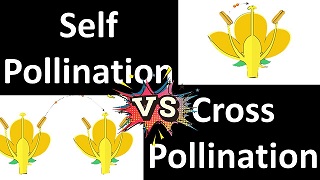
| S.N. | Self-pollination | Cross-pollination |
| 1. | Transfer of pollen grains from anther to the stigma of the same flower (typical self-pollination) or another flower of the same plant (adjacent self-pollination) | Transfer of pollen grains from anther of one flower to the stigma of another flower borne on a different plant. |
| 2. | Anthers and stigma mature at the same time in a flower. | Anthers and stigmas mature at different times in a flower. |
| 3. | Usually, self-pollination doesn’t require any external agent. | It requires external agents like wind, animals, insects, water etc. |
| 4. | It gives rise to pure lines after a few generations. | It cannot give pure lines as it brings about genetic variations. |
| 5. | Less number of pollen grains are produced as they are not wasted. | Pollen grains are produced in a huge quantity as most of them are wasted. |
| 6. | The plants obtained are less resistant to diseases and pests. | Plants are better adapted and thrive being resistant to diseases and pests. |
| 7. | Due to lack of variation, it doesn’t contribute towards evolution. | It plays an important role in evolution because of variation obtained. |
| 8. | Useful characters are preserved by this method. | Useful characters are not preserved by this method because of variation. |
| 9. | Undesirable or defective characters cannot be eliminated by this method. | Undesirable or defective characters can be eliminated by this method. |
| 10. | Yield of the plant falls or decreases with time. | Yield of plant usually increases with time. |